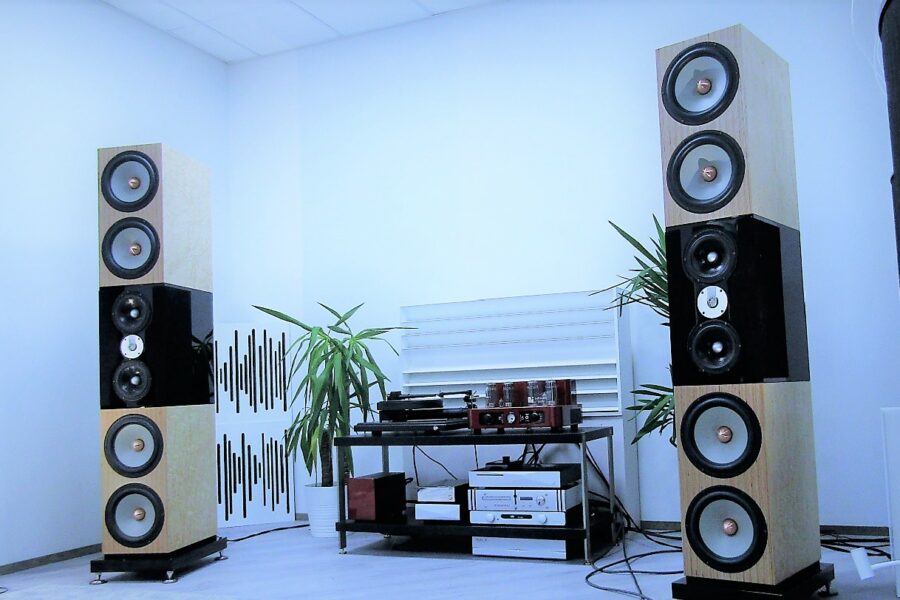Sami Penttilä, the head designer of the Finnish Penaudio, has been hard-working and studious in recent times. Not that long ago came Sonata Supreme and Sonata Signature speakers, both kind of flagship loudspeakers. These two are remarkable loudspeakers in their own right, but they didn’t prevent Penttilä, once he was shown green light, from taking a much bigger bull by the horns, and put his mind on designing something that he has not dared to do before, nor resources to do, namely the new Penaudio Karelia – by far the most ambitious Penaudio loudspeaker until today. Also, by far the most expensive Penaudio so far.
Karelia refers to an area on the border of Finland and Russia, an area that has given rise to the 19th-century work of national epic poetry, Kalevala, compiled by Elias Lönnrot from Karelian and Finnish oral folklore and mythology. The book, telling nothing less than the story about the Creation of the Earth, is one of the most significant works of Finnish literature, and compares to four five similar works found from different parts of the world. The Kalevala had an instrumental role in the development of the Finnish national identity in the late 19th and early 20th century.
I’m not going to waste time and space on the background of Sami Penttilä, or the history of the company for that matter, since INNER has widely covered those topics in various interviews and reviews (see the listing of the latest contributions). At least a half a dozen of Penaudio loudspeakers have been reviewed. All those articles are sufficient to provide a full picture of Sami Penttilä’s ideas of speaker building.
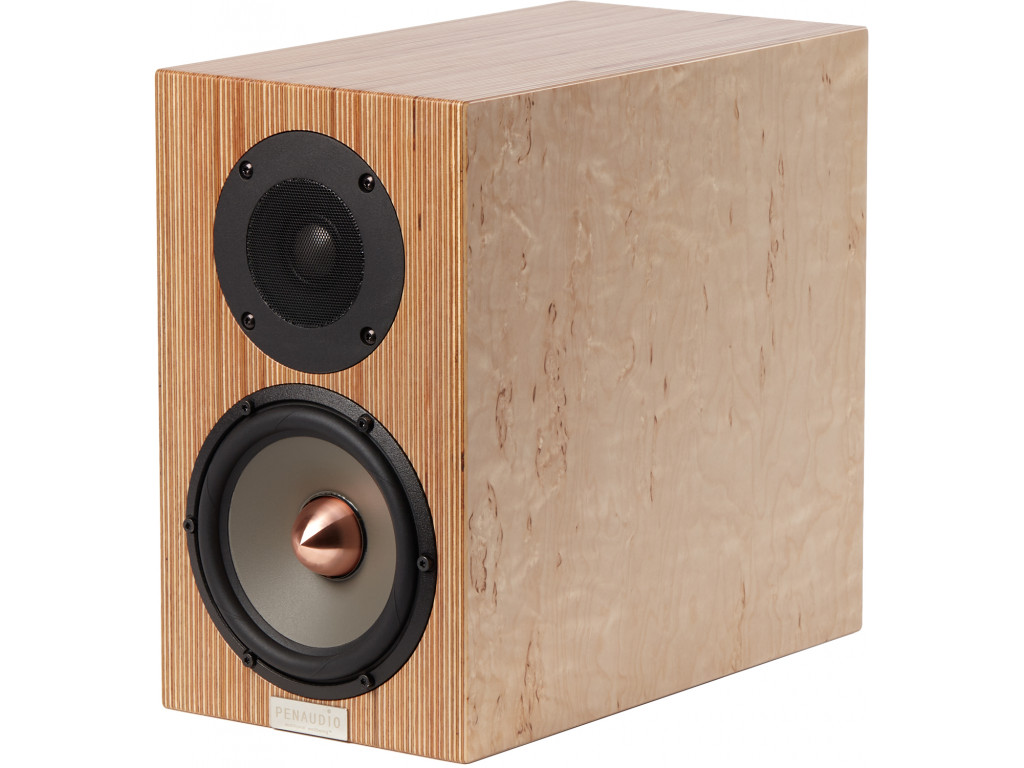
What’s different this time is that, although he’s been designing expensive speakers before, now, thanks to the new company set-up, he was given free hands in designing a speaker with no spiritual or budget constraints, whether regarding the size, the materials or the components. He was simply asked to design the world’s best loudspeaker!
What the above (money’s not an issue) translates into, becomes clear by looking at what goes in the Karelia. All drivers, for instance, represent the absolute best what SEAS can offer. Penttilä has always chosen SEAS to be his source for the driver units but this time he was only looking at the most expensive ones.
In the Karelia, the highest frequencies, 3-4 octaves above 4500 Hz, are reproduced with a help of SEAS diamond membrane tweeter, which according to Penttilä, “responds to the signal quite exceptionally fast due to the lightness and rigidity of the diaphragm , but also thanks to its really powerful motor, the voice coil/magnet system”. Moreover, this tweeter is said to have extremely low distortion. The rear side of the diaphragm is damped with synthetic stuff and fashioned into a diamond shape with virtually no harmful internal reflections.
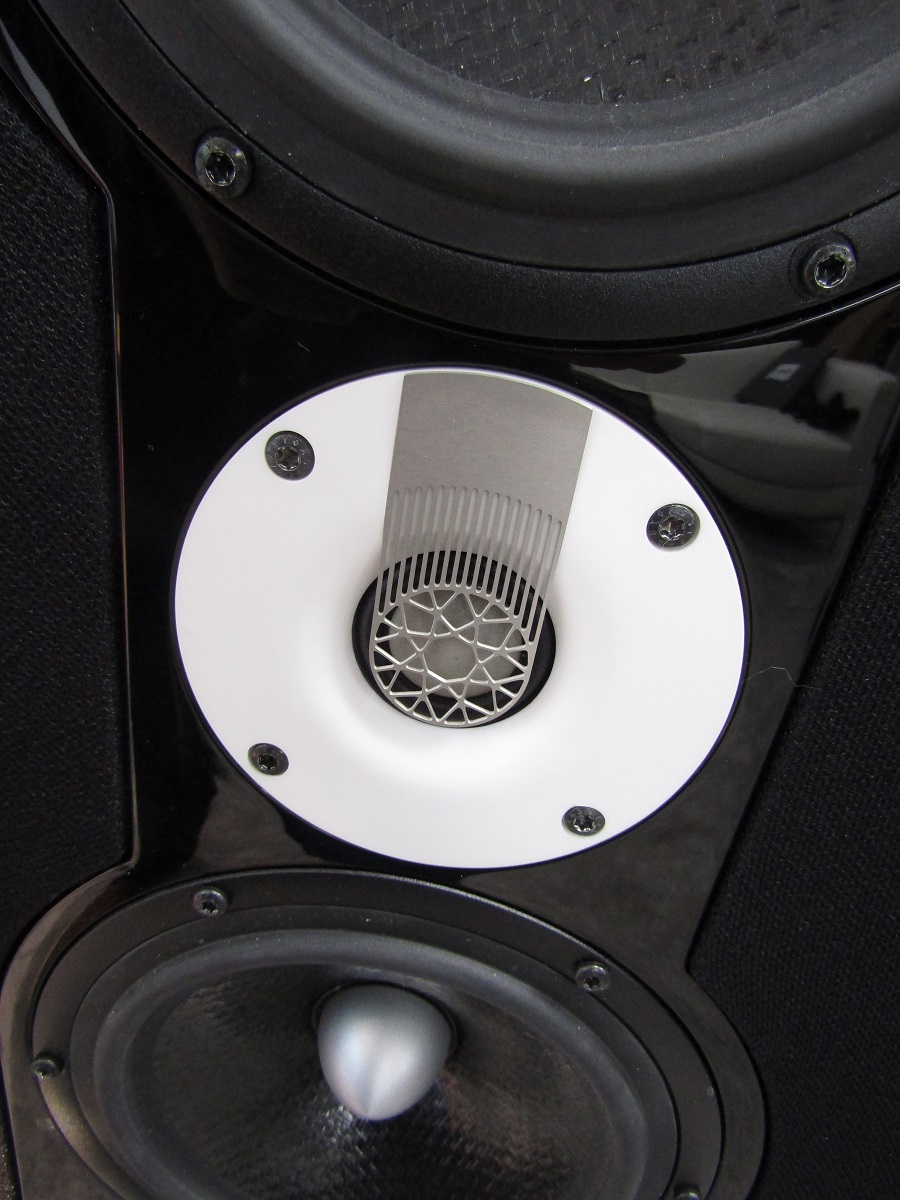
Two low-distortion 180 mm SEAS Excel driver, with a fiber/plastic cone, does the the midrange. Above and below the pole piece of the voice coil are copper short-circuit rings. The titanium voice coil former is custom made in order to have a faster transient response, and a higher Qms. The outer suspension is loosened, and the inner suspension stiffened to withstand increased power. That sort of things.
The woofers are 260 mm SEAS Excels with an “ultra-low-distortion” magnesium/aluminum cone. Four of those per speaker area arranged symmetrically above and below the midrange section. The voice coil is 16 ohms in order to facilitate the design of the crossover filter, and to increase the driver’s Q value.
Penttilä stresses the fact that the materials used in all the listed drivers were so selected that the drivers would suit perfectly to reproducing the frequency range they were designed to reproduce, ie. to be as little resonant as possible as well as fast attacking /decaying (internal damping).
Controlled directivity
So, the drivers are the best what SEAS can manufacture, but more importantly, this time that is only half of the story. For the Karelia, Penttilä says he had to make, more than ever before, serious research work especially related to how the sound radiates and directs itself. As a result, the Karelia is the first Penaudio speaker to feature effective use of controlled directivity, the control being obtained by solutions and measures made on the cabinet itself.
The treble radiation, however, isn’t constrained because “the tweeter naturally directs the sound so much that increasing the directivity would only weaken the stereo image under normal listening conditions”, Penttilä explained to INNER. In addition, the highest frequencies begin to attenuate, in the air, already on their way to the ear of the listener, not to mention how they are absorbed by carpets, sofas, houseplants, and other thick soft surfaces around the speaker. In regard to directivity, the major problem lies in the bass region, where almost any room show modes (standing waves) between 50-200 Hz. There, according to Penttilä, any attempt to direct the sound has the biggest effect. Directing the sound in the midrange can also, in the worst case, lead to an excessive directivity leaving the sweet spot narrow, and the sound outside it: “weird”. In the good case, keeping the radiation angle reasonably wide toward the listening spot reduces harmful reflections from room interfaces, increasing sound accuracy, widening the stereo image and depth, while keeping the stereo image layered over a wider listening area.
The midrange driver is placed vertically on both sides of the tweeter ie. in the D`Appolito way, which in Penttilä’s mind, allows for perfectly seamless overlapping and crossing the treble and the midrange response. Furthermore, since the woofers are symmetrically placed above and below the midrange drivers, the frequency response behavior can be expected to be constant above and below the design axis (the traditional layout gives completely different responses when measured from above and below the tweeter), thus directly affecting the room response.
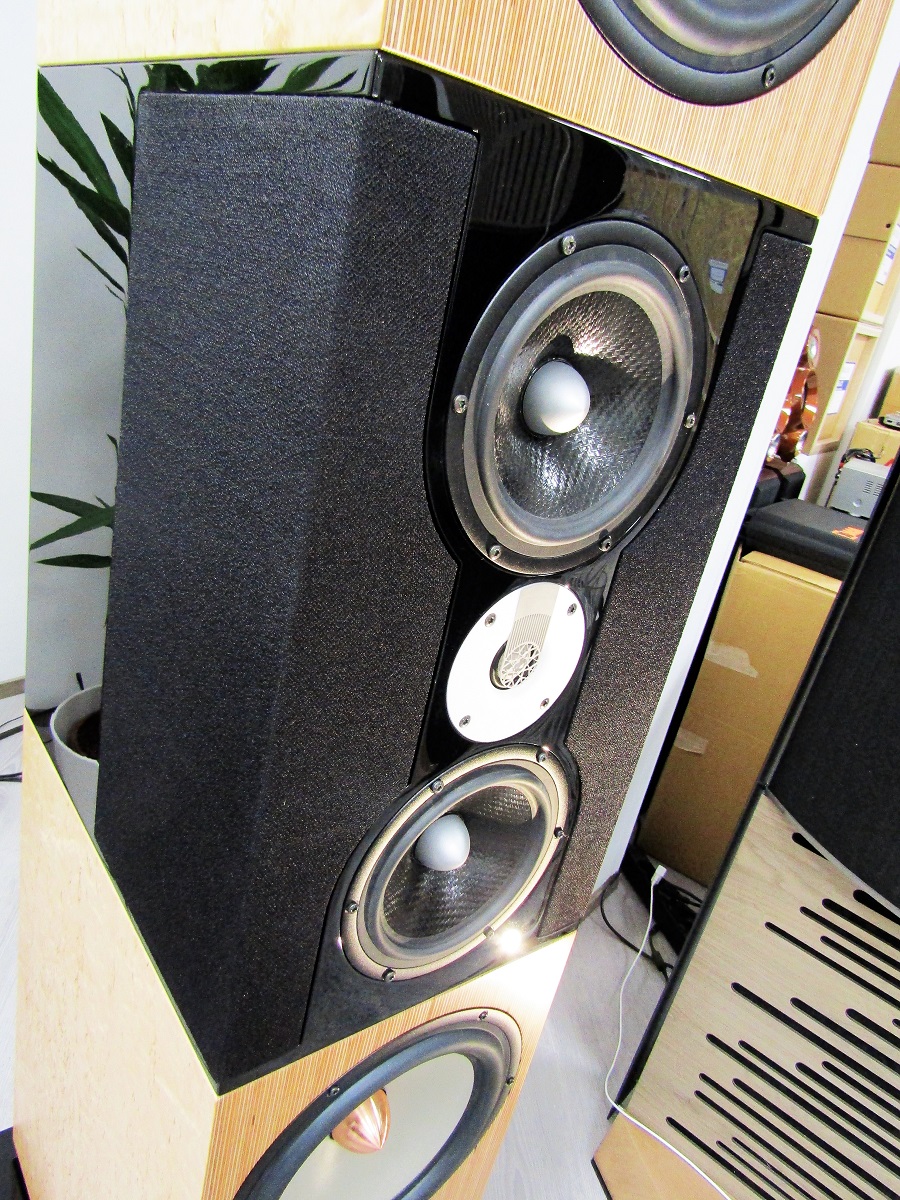
Over the midrange (200 – 2400 Hz), the speaker operates in the cardioid mode. With this directional pattern, virtually no midrange sound is leaking backwards, and the radiation sideways up and down is small. As a result, most of the radiation is directed forward, i.e. towards the listening position. The sound heard at the listening seat comes directly from the drivers and is thus clear from reflections from the nearby walls. The cardioid operation is standardly obtained by attenuating (absorbing) the driver’s rear firing radiation with carefully selected and carefully placed damping material, and with a number of holes on the side and front of the chamber. Combined with a seamless midrange to treble transition, the Karelia is said to deliver an ultimate stereo image, with a real image of depth up and below, unlike in many pure dipoles where, according to Penttilä, the image of the depth is tubelike.
U-frame
The bass of the Karelia is a semi-dipole, implemented with a so-called U-frame cab. However, with a right amount of attenuation the upper bass is made to behave like a cardioid (little rear radiation) in order to make the woofer sound seamlessly coincide with the midrange radiation around the crossover frequency. Due to the limitations of physics, towards 50Hz the bass turns into a dipole (forward and backward, and less to sides, or up and down). In Penttilä’s mind, this is an extremely good feature in the lower bass playback because it prevents the speaker from being omnidirectional (radiating in every direction), and thus prevent the speaker from messing with the room acoustics. The Karelia’s bass reproduction is said to be extremely accurate, fast and authoritative thanks to its housing, and the four ten-inch woofers.
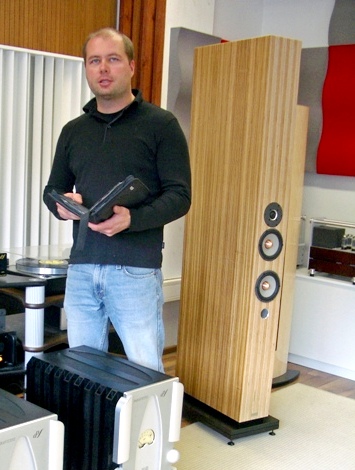
Further questions
It appears that the mid-range cardioid was realized without a perforated plate or the like, and only with applying some damping material. Is that true? And if so, how was this damping implemented knowing how sensitive the cardioid principle is to the accurate dimensioning and application of the material?
Penttilä: Yes, you’re right. The Karelian midrange cardioid cabinet is damped without a perforated or slotted plate. The rear end of the enclosure is damped with a certain density of foam, and the area directly behind the driver, with a selected synthetic damping material, the amount of which is very critical for the end result. The damping material, their amount and location have been determined by means of thorough listening tests because I don’t trust the measurement equipment especially in such a “new” design. It took a few months, but it’s the final result what matters.
Is it really the case that between 50 and 200 Hz the Karelia does not leak the sound backwards at all, and only starts to behave like a dipole below 50 Hz? In other words, is it so that one need not, in assessing the overall sound or response, take into account the reflection from the wall behind from mid to high bass?
Penttilä: The woofer cab of the Karelia is a dipole, but the rear wave is strongly attenuated by a combination of two different damping materials, and by carefully placing them at certain locations. Yes, there is some rear sound leaking in the 50-200 Hz range, but the difference is several decibels as compared to the forward radiation, and thus, the speaker is not as sensitive to the effect of the wall behind as it would be, if it were just be a open baffle.
You’re known for being very selective and uncompromising when it comes to choosing components for the crossovers. How difficult it was this time to find the most fitting crossover parts?
Penttilä: The components used in the crossover filter are accurately “seen” on a speaker like this that produces a direct and clear audio signal. Therefore, by making use of listening tests, Mundorf’s MCap Supreme Evo Silver/Gold Oils were selected as capacitors for the treble and midrange filters, and MCap Evo for the bass arm. The treble and midrange coils are Mundorf’s Hepta Strands, and for the bass MCoil air cores with 2.36 mm wire. Resistors are Mundorf MResist Supremes. With this selection of crossover components we sought extreme sound purity, transparency and accuracy.
You keep telling that at Penaudio you use excessively listening tests in various phase of designing the speaker. Could you shed light on what sort of listening tests they’ve been, what’s the process, how systematic or intuitive they are, are there other listeners?
Penttilä: In my personal listening tests, I use about 10 familiar samples of different type of music in order to get the sound right. After each major correction, I measure the free-field responses … on axis, -30 degrees off-axis, -60 degrees off-axis, and -180 degrees off-axis. In the case of the Karelia, this procedure was much harder to follow than with more traditional loudspeakers, of whose behavior I have more than 22 years of experience, and therefore are easier to control. This is partly because in the Karelia the dampening material of the cardioid attenuators and their locations affect the audible sound more than what can be directly seen from the measured responses. In other words, the normal product development process, which covers making adjustments to the crossover components, when the enclosure volume, resonance tuning, and damping are already fixed, this time the same listening samples had to be used also for tuning the crossover components vis a vis cardioid dampers and their locations simultaneously. There simply were more variables to take into account. Apart from me, two other person whose ear I trust, listened to the speaker during the development phase. The comments I received from them helped me to get out from the maze, a labyrinth, into which I guess all designers every now and then drift. This advice was important because, after a certain time interval, the ear easily becomes insensitive to changes made, and the sound in the morning is different from what it was the night before. When I reach the point where the sound next morning is close to what it was a night before, then I know the design of the speaker is finished.
What exactly did you look for when you embarked upon designing this speaker technically? Not too long ago you published another high-end speaker Sonata Signature, and I’m sure you invested in their design too.
Penttilä: I’d say the Karelia had been on my mind, in fact, as a some kind of outline for years. Two years ago, when it became obvious that I will have the opportunity to design an ultimate loudspeaker, it was already almost like a finished speaker in my head. For instance, I had planned to use the D’Appolito configuration long before the Sonata, but it was the good experiences obtained with the Sonata, that made me apply the D’Appolito principle to the Karelia. After all, it is common knowledge how much the room can affect the sound, and also how the effect can be radically reduced by means of certain enclosure structures. It took me 1.5 years to understand and test different cabinet structures before being able to start developing the Karelia. That is, cardioid and/or dipole for the midrange and the bass.
And soundwise? Comparing to Sinfonia or Sinfonietta?
Penttilä: Soundwise, I was looking for the same qualities that I’ve always appreciated since the very beginning, namely naturalness, deep image, fast response and accuracy. Actually, with the Karelia I was able to reach a sound quality that I couldn’t even imagine before when I was using more traditional solutions. Partly I think this was possible because in this project I was able to do prototyping with Mundorf’s highest quality components, and SEAS modified midrange drivers and woofers. The tweeter was initially SEAS Beryllium Excel, which can now be found in all Penaudio Supreme series of speakers, but we could not resist experimenting with the top SEAS Diamond film tweeter, and that turned out to sound even better. The collaboration with WAD has made it possible for me now to make such expensive experiments. One piece of the SEAS Diamond tweeter cost circa 4000 euro. I don’t think I would have ever even thought about trying one in my loudspeaker before.
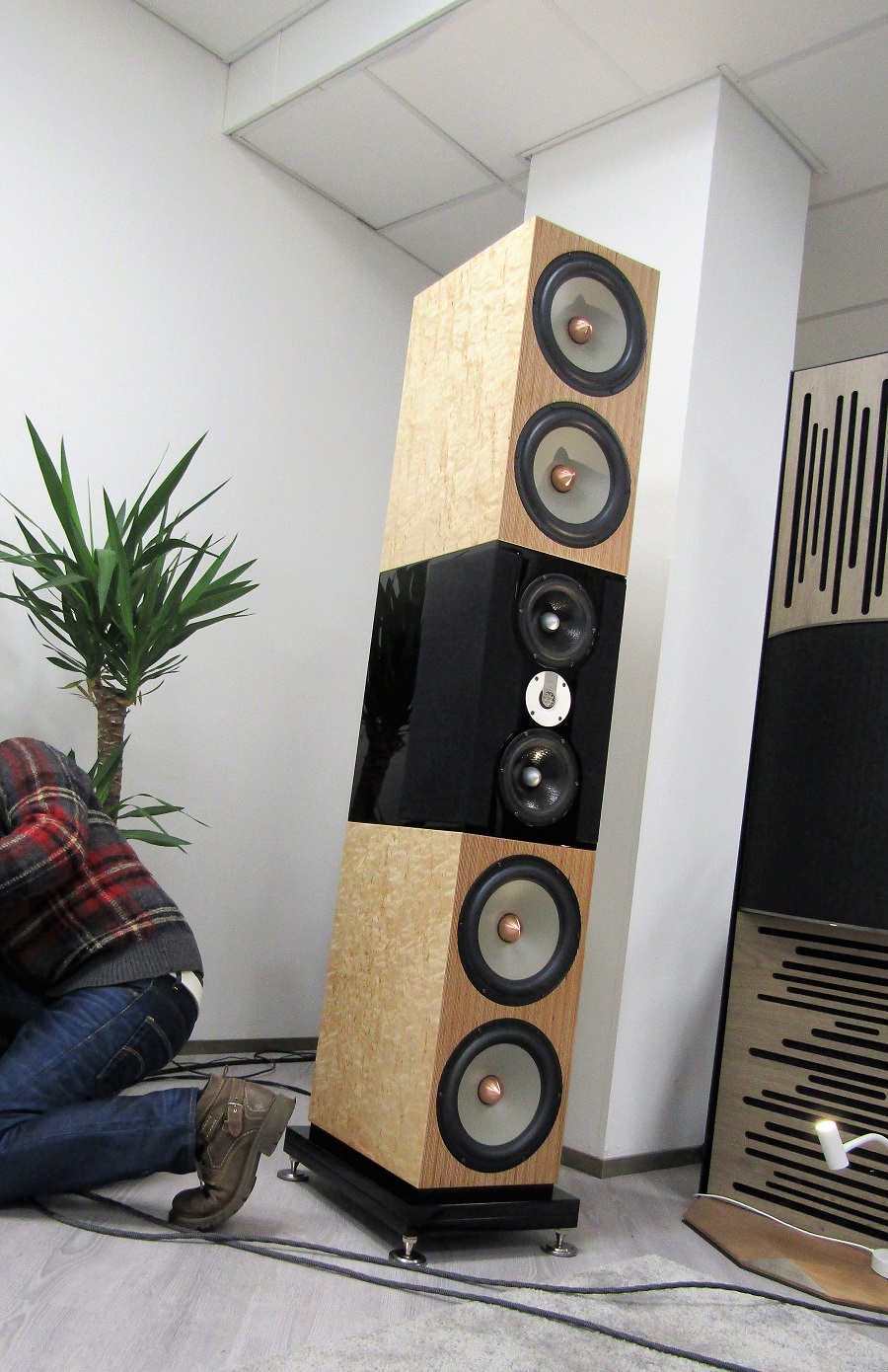
The Karelia
So, finally, what we’re talking about here is a 3-way, dipole/cardioid floorstander, standing 180 cm high and 33 cm wide (44 cm deep), and weighing 60 kg each. As said, for the frequencies above 4500 Hz there is 26mm artificial diamond dome from the SEAS Excel series with patented neodymium magnet system based on 6 radially magneted NdFeB magnet blocks. Efficient ventilation and damping of every potentially resonant cavity behind the dome, surround and voice coil. Precisely mounted copper sleeve reduces non-linear and modulation distortion. The final cuts of the acrylic rear chamber help scatter the internal sound waves with a minimum of damping. Together with non-resonant magnet system this provides the high dynamic response of the tweeter.
The tweeter is placed in the middle of two 176mm OEM SEAS Excel Curv-cone midrange drivers reproducing everything between 200 – 4500 Hz. The driver features a new woven polypropylene cone with excellent internal damping characteristics, together with perfectly matched moving parts, a titanium voice coil, short cut rings above and below the T shaped pole piece, a special designed spider to match the dipole cabinet. The midrange cabinet is some sort hybrid cardioid/dipole.
Finally, below 200 Hz there are four 269mm OEM SEAS Excel woofers with a magnesium/aluminium alloy cone, and copper rings above and below the T shaped pole piece. Woofers are set in an U-frame dipole structure. The crossover includes Mundorf MResist Supreme resistors, Mundorf MCapEvoSilverGoldOil and MCapEvoOil capacitors, Mundorf Hepta Strand and MCoil Air Core inductors, WBT pole screws.
The in-room frequency responce is said to be 25 – 65000Hz; sensitivity: 87dB/1m/2,83V, and nominal impedance: 4 ohms. All amplifiers above 30 W power should be able to drive the speaker.
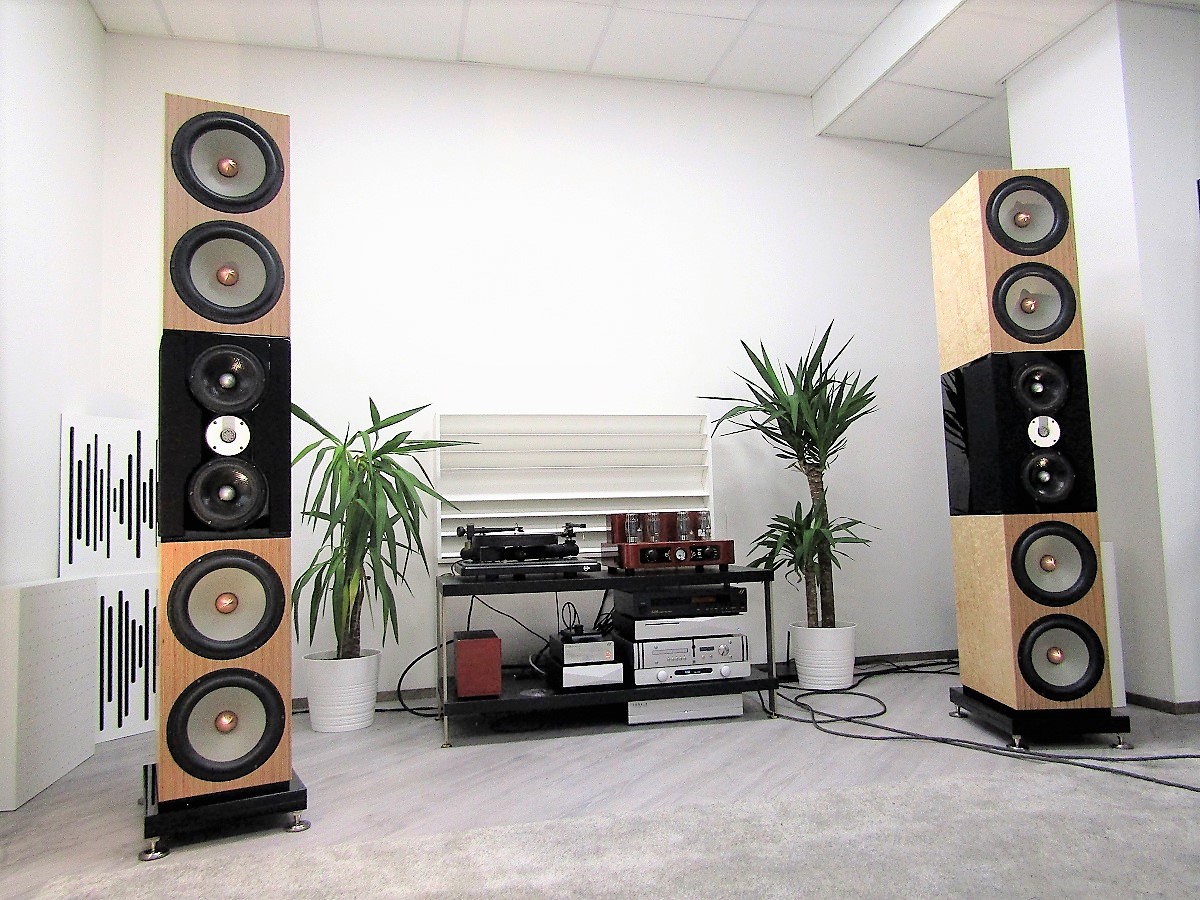
Initial sonic impressions
Let me stress straight away that this wasn’t an ordinary standard review based on extensive critical listening over a longer period of time. But I was able to lend my ear to these mighty speakers for a good while, enough to go through my top-10 selection of test samples and some other music. It’s certainly not enough to get into the inner qualities of the sound, or slowly growing into understanding its idiosyncrasies, which is required to find the most accurate and descriptive terms for portraying the sound, the process of which often takes weeks rather than days. Also, the listening room was not familiar to me, so amplitude anomalies, if any, due to the room or the speaker, may have gone unnoticed by me. Fortunately, this time I had the advantage that I knew Penaudio speakers from the past, having reviewed many of them, including the flagship models such as Sinfonia and Sinfonietta. So I definitively didn’t have to start from the clean table, and I felt myself justified to making comparative judgements between the new Karelia and the previous top models.
From the very start it was obvious that the Karelia possesses massive resources to reproduce just about any music, and do it with a minimum amount of compression or stress. Not surprising, really, when you look at it. The experience is all-encompassing and overwhelming without being overweight. The sheer amount of sound energy that the ear will embrace, the ease of its outputting, absence of effort. No need for showing off, no pomping, just a comprehensive presentation, and gentle authority. No tension, no coercion. The loudspeaker does what it is asked to do, with a big margin and headroom.
Bob Minzer and his Big band was a much telling example. Some tracks of this album require lots of space, air and openness for the sound to be ear-friendly and enjoyable. The Karelia didn’t get winded with saxes and cymbals, didn’t mind coarse sidetones. Drums were kicking good although not overly powerfully. The occasionally harsh sound of the big band is audible to the ear but mostly assumes a civilized and effective treatment. For some reason I got the impression that there was a smaller speaker singing inside a bigger speaker. Not that the smaller one would not have been able to handle the demanding sections all by its own; more likely it was due to the fact that the woofer part was reluctant to get involved when there was no real reason to do so – here’s something for further investigation.
As it was clear that loads of music went into the Karelia, I equally sensed that tonally something had changed from its previous top models, something that is not readily explicable. Certain Penaudio’s perennial preferences were still there, for instance, how vocal music was reproduced smartly and in a sympathetic manner. Jessica Pilnäs’ soft voice came through tonally quite correct and fine-featured, if you like, only the size of her voice giving signs of being mildly overemphasized (the enlargement didn’t add extra qualities to the sound). Throughout its history, Penaudio has emphasized, again and again, that it tunes its loudspeakers for relaxed and easy-going moments of life, loudspeakers that are enjoyable to listen to, rather than dry and analytical, speakers that go well with good wine and food. Food I don’t know, but with the Karelia, in place of wine, I’d recommend pure, natural and clear spring water from the mountain. The Karelia is a Penaudio loudspeaker that one can listen to with a bright mind and clear eyes.
The sound balance wasn’t mellow, rounded, or bassy. Let me explain. It’s essential to keep in mind that Penaudio’s previous top models have been tuned, quite deliberately so, to match the volume of the listening space, and therefore the bass has been super-sensitive to the surroundings. Place a big Penaudio in a slightly smaller room than it was intended, and the bass easily gets out of hand. Along with the Karelia, this property seems to have disappeared, or at least diminished. For the most part, I was utterly unable to make the Karelia and its quasi-dipole woofer part sound boomy, not with my limited choice of test music at least. I’m not saying the Karelia is immune to the room, but I am saying that the room is more helpless in trying to blow up and overstate the bass than with the previous flagships.
Two examples. Michell Wollny Trio: from low to mid bass, the notes were reproduced quite in line with the midrange, not masking it, not hanging all over the room. The (double) bass wasn’t cannonlike, but mainly came out according to the book. Occasionally, I might have liked the bass be a bit more distinctive, clean, but as long as the Karelia kept the midrange resolute and open, without being sharp or light, things were alright.
The blues guitarist Jonny Lang offers quite a bit of material for (electric) bass lovers from loose and slow to quick and tight, with a good deal of pitfalls too. The Karelia’s strategy here was to provide a little tamed but mostly correct presentation, letting the very bottom bass be a little under-represented, and then giving more authority to mid to high bass. In other respects, Lang’s blues playing got fine treatment, sometimes energetic, sometimes tense but never unpleasant. In the mixture of things, maybe the guitar could have been better featured, now Lang’s vocal parts stole attention.
Ian Boldridge singing Bach’s arias: here I felt that the Karelia somehow tried hard to be as impartial as it could in front of this transcendentally beautiful music but not quite succeeded. The line between being neutral and being expressive is fine, and that’s where Penaudio’s loudspeakers always do their art. The sound was airy and spacious in the way open back speakers often are. It was noticeable that the speaker preferred not to push the tenor voice forward. The music was fast moving, but could have sounded more bouncy. Quality stuff still.
A loudspeaker in this class cannot do whatever it wants. Basically, it must know everything. Because of this the Karelia replaced the drama and excitement of Nicola Porpora’s vocal music with a very sure-footed and consistent reproduction. No show time here. The Karelia isn’t a fervent or provocative speaker, yet surely able to blow spirit to music.
Another example: Alan Plaines on Janacek’s piano pieces. For the most part, the piano is reproduced tonally correctly, naturally and effectively, the Karelia sitting on the fence trying not to sentimentalize or glorify the piano sound too much. The Karelia sounds like a big speaker but not a huge one, and that’s an advantage. The soundstage is of a sensible size, and the focus well in between the speakers.
Yo Yo Ma playing solo American repertoire was among the most appealing CDs during this preliminary listening session. His excellent performance was nicely passed over, and the timbre of the cello beautifully conveyed. First and foremost, the Karelia showed how even a solo cello requires sufficient power reserves from the loudspeaker’s side to do justice to this music. This was a truly a high class listening experience, as it was to hear Glenn Gould & Jaime Laredo playing Bach’s violin sonatas. I expected rhythmically a bit more upstanding performance, but all in all the whole was convincing. Here the music, sound and the loudspeaker approached a perfect match.
The Karelia is now selling for 84 995€ per pair. Not many pairs will be manufactured, so be aware, if you’re after a loudspeaker of this calibre.


